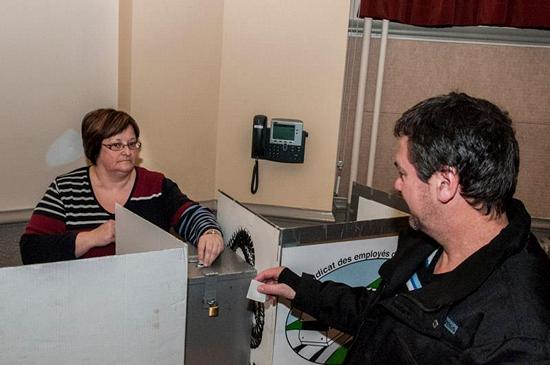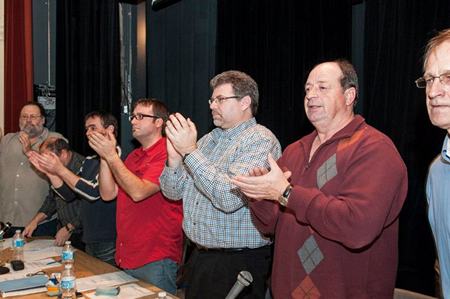
|
December 7, 2012 - No. 155 Strike Ends at Bombardier in La
Pocatière, Quebec Workers Force Bombardier to Meet
|
 Mario Lévesque, President of the Bombardier workers' union addresses the workers at the December 5, 2012 meeting. |
As far as the 2010 letter signed by Bombardier and the union, the union is continuing its legal action. "This 2010 agreement which has been violated by Bombardier has been added as an annex to the collective agreement. Our legal fight on this carries on. There was a hearing in October and another one is coming in December," said Lévesque.
The union is also satisfied with the provision in the collective agreement that improves the pension benefits of the workers. "We have a defined-benefits pension plan," Lévesque said. "We negotiated a global increase of 18 per cent in the pension benefits of our workers."
La Pocatière workers have great conviction in the struggle they are waging for the region and greatly appreciate the support they have received from the workers from many sectors of the economy and the people of the region. Lévesque said:
"This success does not belong solely to the bargaining
committee. Far from it. Everybody took part in the struggle. We were
greeted with incredible solidarity from the workers of other unions,
from our own federation and from the people of the region. They all
came to us with their support. At the heart of this
was all our members who stood up for one another and closed ranks. They
are convinced that we are waging the good fight for the future of the
region, especially for the youth, and that we have gained something
from this fight. We went on strike for 35 days to achieve the
satisfaction for our demands and we did
it."




(Translated from original French by TML. Photos: M. Giroux/CSN)
Bombardier Workers Vote 82.2 Per Cent
in Favour of Offer



In a vote by secret ballot on Wednesday evening [December 5], the Bombardier workers in La Pocatière (Fédération de l'industrie manufacturière -- Confédération des syndicats nationaux (CSN)) ratified by a vote of 82.25 per cent a proposal that the conciliator, Jean Poirier, sent to both parties on December 2 in an attempt to settle the strike. Workers are expected to return to work right away. At the meeting, the union council, representing all the union delegates, recommended that the members endorse the conciliator's proposal. This proposal dealt mainly with issues on which there was no agreement between the parties, such as subcontracting, the wage scale and the retroactive payment of the wage increase to when the contract expired, and the transfer of the pension fund to Bâtirente (CSN).
The proposal included all the items agreed to since negotiations began. The vote was on the whole contract, both the articles already agreed to and those dealt with by the proposal. Workers had to agree with or reject the whole thing.
Subcontracting Restricted
With this agreement, the employer guarantees that the primary parts in stainless steel will be manufactured and assembled in La Pocatière provided the company has the required equipment and machinery. It must also ensure that all work shifts are completely filled before it is allowed to contract out the jobs.
The company also commits to maintain in good shape, for two years, the existing equipment and machinery needed for the manufacture of parts. It also commits to keep in good shape four major machining departments for the duration of the collective agreement. With this agreement, the union blocks the exodus of state-of-the-art equipment from La Pocatière to other Bombardier facilities.
The company commits as well to investments in highly specialized welding equipment and a higher-performance folding machine. The company will return to the La Pocatière plant the manufacture of primary parts in stainless steel that are being made in Mexico at another Bombardier facility.
Bombardier commits to build in La Pocatière 10 pilot cars and 20 other parts for the New York contract (R179) as well as components of the San Francisco contract (BART).
As far as the transfer of the pension fund to Bâtirente (CSN), the employer only agreed that current employees may, if they so decide, transfer their pension for their future contributions. The new hires will not be allowed to do that.
The wage increase is 1.5 per cent retroactive to October 2011 up to September 30, 2012 and a one per cent lump sum for the same period.
After that the following wage increases kick in:
- two per cent from October 1, 2012 to September 30,
2013;
- two per cent from October 1, 2013 to September 30, 2014;
- two per cent from October 1, 2014 to September 30, 2015;
- 2.5 per cent from October 1, 2015 to September 30, 2016.
The unionized workers also make important gains in their pension fund, almost closing the gap with Bombardier's Ontario plant.
A Victory Born of Solidarity
According to the union president, Mario Lévesque, this new agreement, which restricts subcontracting, is a victory not only for the workers but for the whole region because it guarantees the current jobs while opening up the possibility for the creation of more: "We owe this major gain to the solidarity of workers and everybody who supported the workers in their fight for jobs."
The 330 unionized workers were without a contract since September 30, 2011. The strike lasted over a month.
(Translated from original French by TML. Photos: M. Giroux/CSN)
Reference Material from New York Times Series
Explosion of Pay-the-Rich Schemes in the U.S.


Part 1: How Taxpayers Bankroll Business
The vast expansion of schemes to channel public funds to corporations is the theme of a three-part series in the New York Times under the general heading "United States of Subsidies." The report is apparently the result of a team of journalists pouring over 150,000 city, county and state documents itemizing public funds handed over to private corporate interests in various ways. Over $80 billion per year of local public money was channeled to private corporate interests during the period studied from 2007 to 2012. These payments amount to a large percentage of local revenues. According to the data, Texas doles out at least $19.1 billion per year to private corporate interests amounting to 51 per cent of the state budget or $759 per capita.
Forty-eight monopolies are listed as receiving over $100 million dollars each from city, county and state public authorities since 2007, while 5,000 more companies listed have been the recipients of between $1 million to $100 million each. The material does not put subsidiaries together with parent companies as single recipients of public money. Nor was it within the scope of the report to detail the individual owners of capital who benefit from the public money. The report does contain the occasional listing of CEO claims on company revenue and compares the claim with the public money given to the company.
The 1,874 different programs created to hand over public
funds or otherwise enrich corporations and their owners of capital,
such as free or discounted services, are detailed in an interactive
database available at the New York Times website.
The database lists the city, county and state programs for each state and the total amounts per year using an interactive map of the United States. It also provides the names of the 48 largest recipients and the states and other local authorities from which they received public monies and the names of the programs and amounts. Five thousand other companies are also included in the database and the local authority, amounts and programs. The authors say that at the local level full information was difficult to find given the reluctance of authorities and shoddy bookkeeping. In many cases, the officials could or would not say why the public money was handed over or what free services were provided, and what if anything was returned such as the number of jobs created. Job creation was said to be the single biggest rationale for handing over public money and services.
The database assigns the programs to eight broad categories, although it appears that many of the programs are simply inventions or concoctions to satisfy the aim to hand over public money to private interests. The programs are either specific to a company or blanket programs applying to all qualifying companies within the sector or region. The category dealing with corporate taxation takes the legal level of taxation for all companies and details how programs would reduce the legally required amount for individual companies or provide a rebate. This area is murky as many monopolies pay little or no corporate tax even before special rebates, credits or reductions are factored in. No comment or data is given whether the legal federal, state, county and city taxation levels are appropriate or not, or how they compare with past levels. Nor does it allude to any controversy over how much governments at all levels should claim directly from gross income of all enterprises active in the socialized economy.
The Eight Categories
1) Cash grant, loan or loan guarantee
Example -- $230 million from South Carolina as a General Obligation Bond for the Boeing Company, 2011
2) Property tax abatement
Example -- School Property Tax: Special Appraisal for Texas Agricultural and Timber Land worth $3.27 billion for qualifying companies in fiscal year 2013
3) Corporate income tax credit, rebate or reduction
Example -- California Research and Development Tax Credit worth $2.29 billion to qualifying companies in fiscal year 2012
4) Free services (all aspects of infrastructure)
Example -- Alabama Industrial Development Training, $33.2 million, fiscal year 2011
5) Sales tax refund, exemptions or other sales tax discounts
Example -- Massachusetts exemption for materials, tools, fuels and machinery used in manufacturing, $1.29 billion in fiscal year 2013
6) Equity investment
Example -- Maryland Sunny Day Fund, $1.6 million, fiscal year 2011
7) Personal income tax credit
Example -- New York, Empire Zone and QEZE Credits, $265 million, 2012
8) Corporate income
Example -- West Virginia, Net Operating Loss, $178 million, no year given or details of how the program works
Top 12 Monopoly Recipients of City, County and State
Public Funds
(Not Including Federal Funds)
General Motors: Awarded at least $1.77 billion from 208 grants in 16 states.
Royal Dutch Shell: Awarded at least $1.68 billion from 35 grants in three states.
Ford: Awarded at least $1.58 billion from 119 grants in eight states.
Chrysler: Awarded at least $1.4 billion from 14 grants in three states.
Like the two other auto monopolies, Chrysler closed numerous facilities in recent years. The mayor of Kenosha, Wisconsin said Chrysler left a site in the city without cleaning up toxic waste.
General Electric: Awarded at least $381 million from 132 grants in 21 states.
GE regularly pays no corporate tax in the U.S., employing over 1,000 workers in its tax department to avoid tax. The CEO of GE Jeffrey Immelt led President Obama's jobs council. Some joke that Immelt's biggest or only job creation program is corporate tax avoidance.
Boeing: Awarded at least $338 million from 81 grants in 11 states.
The military/commercial monopoly's recent grant in Florida came from a program known as Space Florida and is tied to a Boeing facility in Cape Canaveral near NASA's facilities.
Amazon: Awarded at least $348 million from 22 grants in nine states.
Ryman Hospitality Properties (formerly Gaylord Entertainment): Awarded at least $300 million from two grants in two states.
This real estate investment trust began with the billionaire Gaylord family, which owned or owns media outlets (Oklahoman) that consistently rail against social programs and the "evils of public money used as individual entitlements."
Revel Entertainment: Awarded at least $261 million from one grant in one state.
The casino company is receiving tax refunds from New Jersey.
Microsoft: Awarded at least $312 million from 20 grants in four states.
Prudential Financial: Awarded at least $226 million from 18 grants in seven states.
The insurer has long been based in New Jersey, yet the state paid it $211 million in 2011 when the company threatened to leave.
Dow Chemical: Awarded at least $217 million from 187 grants in seven states.
When the long-time Michigan-based company decided to build a solar factory, the state kicked in $140 million and the federal government $20 million. The public funds total around the same amount Dow is spending on the project.
Other Notable Monopolies in Top 48 of Particular Interest to Canadians
Weyerhaeuser: Awarded at least $406 million from 85 grants in 14 states.
Much of the incentives given to this paper company have come in the form of worker training or property tax abatements. The company, which also received large tax credits from Oklahoma, announced a 13 per cent increased dividend for its equity shareholders in October 2012.
Electrolux: Awarded at least $181 million from 14 grants in three states.
Tennessee and the city of Memphis paid $132 million to Electrolux to close its operation in Quebec and move it to Tennessee.
Norampac Unit (Cascades): Awarded at least $143 million from 12 grants in New York State.
In recent years, the forestry monopoly has closed mills in Thunder Bay, Montreal, Red Rock, Pickering and Trenton.
Selected Economic Sectors Involved in Pay-the-Rich Schemes Handing over Public Money to Private Interests
At least 106 manufacturing programs in 35 states, for a total of $25.6 billion.
At least 213 agricultural programs in 41 states, for a total of $8.22 billion.
At least 63 oil, gas, mining programs in 22 states, for a total of $2.5 billion.
At least 86 film industry programs in 40 states, for a total of $1.51 billion.
At least 85 technology programs in 34 states, for a total of $851 million.
At least eight electricity programs in seven states, for a total of $628 million.
At least 46 aircraft programs in 22 states, for a total of $471 million.
At least 11 print media programs in 10 states, for a
total of $276 million. (Note: The New
York
Times itself received $24.4 million in five cash grants
from New York City and College Point in Queens.)
At least six defence programs in five states, for a total of $258 million.
At least 50 alternative energy programs in 23 states, for a total of $235 million.
(To be continued with
additional data from the report. To Come: "Winners and Losers in Texas"
and "When Hollywood Comes to Town.")
Read The Marxist-Leninist
Daily
Website: www.cpcml.ca
Email: editor@cpcml.ca


 TML congratulates
the Bombardier workers for
their resolute struggle in defence of their living and working
conditions and those of the whole region. The workers were successful
in forcing Bombardier to meet their demands on the three main issues in
the strike -- opposition to job losses through
subcontracting, improvement of the pension fund and the wages. This
will benefit not only the workers themselves, but the future of the
region, where Bombardier is one of the only big manufacturing
plants remaining. The loss of manufacturing has had a serious impact on
communities and the living standards of
the people there.
TML congratulates
the Bombardier workers for
their resolute struggle in defence of their living and working
conditions and those of the whole region. The workers were successful
in forcing Bombardier to meet their demands on the three main issues in
the strike -- opposition to job losses through
subcontracting, improvement of the pension fund and the wages. This
will benefit not only the workers themselves, but the future of the
region, where Bombardier is one of the only big manufacturing
plants remaining. The loss of manufacturing has had a serious impact on
communities and the living standards of
the people there. The workers at La
Pocatière say they have put
language in the contract that will help preserve and increase the
number of jobs at the facility. "We have achieved some good success
with our strike," Mario Lévesque, President of the Syndicat des
employés de Bombardier Transport la Pocatière told TML.
Lévesque
said,
"We
have won the agreement that the machinery will have to be
working at 100 per cent capacity before jobs are subcontracted. This
means that the company will have to keep these machines operating 24/7
before it can subcontract the manufacture of parts made on that type of
machinery. That is
a big gain for us. Bombardier has also committed to keeping all the
existing machinery in good order so as to maximize production. We have
put in the contract that all stainless steel parts are going to be made
in La Pocatière. There are parts we have lost that will be
coming back in 2013 when the machinery in
La Pocatière that cuts this type of steel starts working below
its full capacity."
The workers at La
Pocatière say they have put
language in the contract that will help preserve and increase the
number of jobs at the facility. "We have achieved some good success
with our strike," Mario Lévesque, President of the Syndicat des
employés de Bombardier Transport la Pocatière told TML.
Lévesque
said,
"We
have won the agreement that the machinery will have to be
working at 100 per cent capacity before jobs are subcontracted. This
means that the company will have to keep these machines operating 24/7
before it can subcontract the manufacture of parts made on that type of
machinery. That is
a big gain for us. Bombardier has also committed to keeping all the
existing machinery in good order so as to maximize production. We have
put in the contract that all stainless steel parts are going to be made
in La Pocatière. There are parts we have lost that will be
coming back in 2013 when the machinery in
La Pocatière that cuts this type of steel starts working below
its full capacity."